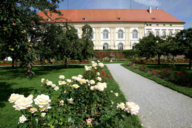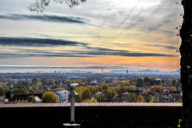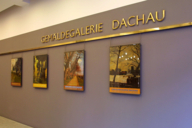
The view from the gardens of Dachau Palace extends over and beyond Munich, which is just 20 kilometres away. On some special days, the vista is even crowned by an incredible panorama of the Alps. At the foot of the former summer residence of the Wittelsbach family, you will find Dachau’s picturesque Altstadt neighbourhood, with its brightly painted houses.
- Dachau and its history
- Dachau the city of art
- Trade roads, Bezirksmusuem (district museum) and art gallery
- The Bavarian poet Ludwig Thoma in Dachau
- Dachau: How to get there from Munich
Dachau is closely linked with Munich not only geographically, but also in modern history. It was in Munich that Hitler began his ominous rise to power. Then, just a few weeks after he was elected Chancellor of the Reich, the Nazis built the first concentration camp in Dachau, for the purposes of persecuting and eliminating their political opponents. Most visitors make the journey to Dachau primarily to visit the concentration camp memorial site there.
What many of them do not realise is that the close connection between the two cities actually dates from much earlier. Very few people are aware of the important role Dachau had as one of the first artists’ colonies; much like Munich, Dachau was an art centre which made a major contribution to the development of modern art.
During the 19th century Dachau, like neighbouring metropolis Munich, flourished as an art centre. Many famous artists came to explore Dachau and the charming natural scenes in the area: Carl Spitzweg, Max Liebermann, Lovis Corinth, Ludwig Dill, Adolf Hölzel and Arthur Langhammer, to name but a few. In fact, it is only a few years since the discovery of a sketchbook that Emil Nolde used when he spent time in Dachau to attend Adolf Hölzel’s painting school, from March to October 1899.
So we can see that, more than 100 years ago, the city became one of the first artists’ colonies – alongside Worpswede and Barbizon. Today, Dachau is a member of the euroArt European Federation of Artists’ Colonies. Many interesting artists still come here to work, and the town is defined by exhibitions and studios.

Dachau is older than Munich. The earliest reference to it dates from 805, when it was named in a deed of gift to the bishopric of Freising. The town’s history is closely connected with the state capital of Munich by way of the former Bavarian sovereigns: Otto I of the Wittelsbach family inherited the earldom of Dachau in 1182. Because of its strategic location at a crossing of the trade roads between Munich, Augsburg and Freising, Dachau was also an important market.
The permanent exhibition in the Bezirksmuseum (district museum) opposite the Church of St. Jakob offers an insight into historic Dachau. Spanning some three storeys, the museum’s collection numbers over 2,000 items relating to the cultural history and folklore of Dachau and its environs. The art gallery located just beside the tourist information office is another extraordinary museum that is well worth a visit. The gallery is dedicated to showcasing works produced by the Dachau artists’ colony between 1870 and 1914.

It is impossible to write about Dachau without mentioning Bavarian poet Ludwig Thoma. He originally arrived as the city’s first lawyer, and was inspired to write by the people of Dachau. Thoma opened his law firm in 1894, in a building known as the Raufferhaus – which is still standing today. He also had a seat at the “Stammtisch” (regulars’ table) in the Zieglerbräu inn beside the town hall.
Here are his words explaining why he decided to settle in Dachau: “As we came up the hill, and the market square with its gabled houses lay before me in its evening tranquillity, I was overcome by a deep longing to live amid this stillness.” Although it is no longer quite as still as it was then, Dachau’s old town has lost none of its charm.
S-Bahn (S2) connection: approx. 20 minutes. Information at bahn.de
Car: approx. half an hour via the A99 and A92 motorways